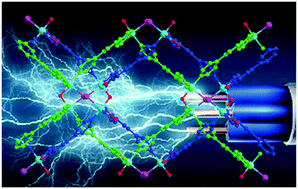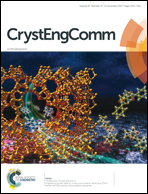Metal–organic frameworks based on halogen-bridged dinuclear-Cu-nodes as promising materials for high performance supercapacitor electrodes†
Abstract
Two halogen-bridged di-nuclear Cu-based 3D porous metal–organic frameworks (MOFs), {[Cu2Cl(OH)(L)2]·(CH3OH)4}n (1) and {[Cu2Br(OH)(L)2]·(CH3OH)4}n (2), have been obtained via solvothermal methods with the bi-functional ligand (HL = 4,2′:6′,4′′-terpyridine-4′-carboxylic acid). These Cu-based frameworks exhibit similar two-interpenetrating frameworks, and 1D channels were left in the packing structures. These MOF materials were then applied as electrode active materials in supercapacitors. Compound 1 presents a high specific capacitance and good cycling stability in 6 M KOH electrolyte compared to 2. The maximum specific capacitance of electrode 1 could reach 1148 F g−1 at a current density of 0.5 A g−1, along with a high capacitance of 90% retained after 2000 cycles at a current density of 10 A g−1 in a 6 M KOH solution. The successful introduction of halogen and hydroxyl ions into the final structures might be responsible for the high performance of the supercapacitor, which makes these Cu MOFs a candidate for an electrode active material for electrochemical energy storage.



 Please wait while we load your content...
Please wait while we load your content...